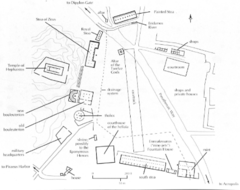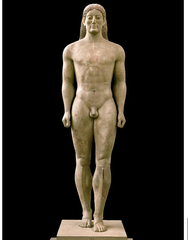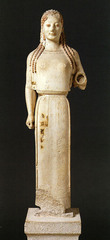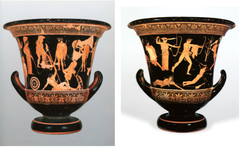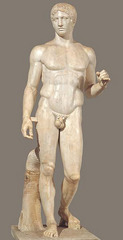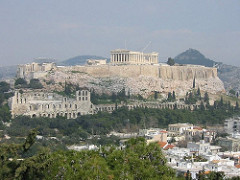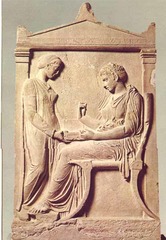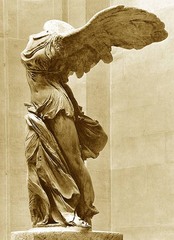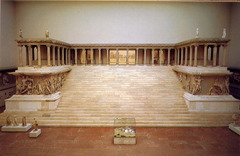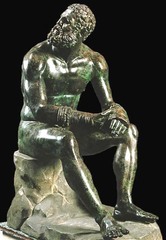26. Athenian agora. Archaic through Hellenistic Greek. 600 B.C.E.-150 C.E. Plan.
-primarily made of stone
-large part of Athens
-content: stoas (place for public discourse discussions, discussion of business, and shared walkways), public offices, shops, temples, library, concert hall
-function: center for the city, citizens gather for market, performances, sports, and other events
-showed educational role of city and Athens' prosperity and use of democracy
-themes: democracy, religion, community, prosperity
-context: highly patriarchal society (only Athenian males could be citizens/participate in democracy), Pericles was successful leader of Athens and oversaw development of agora and acropolis
-temple of Athena overlooks agora (Athena was patron and protector of Greece)
27. Anavysos Kouros. Archaic Greek. c. 530 B.C.E. Marble with remnants of paint.
-ideal human body: athletic, tall, muscular
-used as grave marker
-honored youth died in battle
-naturalistic idealism
-resembles egyptian art/ka statues (Menkaure and his wife)
-archaic smile
-emphasizes importance of male figure, noble death, and athleticism
-inscription connects to Greek religion
28. Peplos Kore from the Acropolis. Archaic Greek. c. 530 B.C.E. Marble, painted details.
-Athens, Greece
-woman (possibly Athena because of adorned dress, headdress, and bow)
-function: honoring Athena (either an offering or a depiction)
-raised left arm and archaic smile (shows well-being, not emotion) representative of archaic style
-brightly painted with animal figures on clothing to represent fertility and prosperity
-kore (young women) statues were offerings to goddesses
-closely tied to Greek gods/religion
33. Niobides Krater. Anonymous vase painter of Classical Greece known as the Niobid Painter. c. 460-450 B.C.E. Clay, red-figure technique.
-one side depicts punishment of Niobe for her hubris, other side is more disputed though seems to depict Hercules (could be surrounded by gods or warriors being placed under protection)
-one of the first times not using isocephalism
-function: utilitarian (mix water and wine)
-themes: increased organic form, figures in nature, landscape, mythology/religion
-naturalism
-context: Niobe boasted her fertility (14 children) to the god Leto, gods punished her by killing all her children
-possibly influenced by cave paintings
34. Doryphoros (Spear Bearer). Polykleitos. Original 450-440 B.C.E. Roman copy (marble) of Greek original (bronze).
-Polykleitos' treatise "Kanon": cannon of proportions/perfect proportions/harmonic proportions (cross-balance all parts of body)
-importance of ideal figure and perfect proportions
-early classical
-original location: Pompeii (where athletes trained)
-contropposto
-mascular, ideal body
-Greek emphasis on athleticism and perfect human body
35. Acropolis. Athens, Greece. Iktinos and Kallikrates. c. 447-410 B.C.E. Marble.
-upper city
-Parthenon
-the Plaque of the Ergastines (presenting peplos to Athena)
-Helios, Horses, and Dionysus (birth of Athena from the head of zeus, inside pediment of temple of Athena Nike, also called Elgian Marbles)
-Temple of Athena Nike
-Victory adjusting her sandal
36. Grave stele of Hegeso. Attributed to Kallimachos. c. 410 B.C.E. Marble and paint.
-Athens, Greece
-High Classical
-relief carving
-servant/slave girl holds out box to older/more mature woman on a klismos (chair) with feet elevated, older woman holds up necklace
-made to adorn the grave of Hegeso
-shows Hegeso's status and power (hierarchy of scale, necklace, and servant with poorer dress), shown positively to celebrate life after death
-themes: contrast between classes, respect of the dead
-hyper-realistic, emotionless faces, motionless bodies, daily life (typical of high classical art)
-context: women secluded to home, extremely wealthy father (mentioned in epitaph), patriarchal society
37. Winged Victory of Samothrace. Hellenistic Greek. c. 190 B.C.E. Marble.
-aka Nike of Samothrace
-Samothrace, Evros
-wet drapery
-built to commemorate naval victory
-nike=symbol of victory
-dramatic, hyper-realistic
-context: build to stand in or above fountain with cascading water, hellenistic style, Greek cultural emphasis on victory/success/prosperity
38. Great Altar of Zeus and Athena at Pergamon. Asia Minor (present-day Turkey). Hellenistic Greek. c. 175 B.C.E. Marble.
-in one of the terraces of the acropolis
-frieze: carved in high relief, depicted gigantomachy (war b/w gods and giants), Athena fighting giants and being crowned
-ionic columns
-altar w/ fire to worship zeus
-function: worship/sacrifice
-Greek victory over chaotic forces of nature/phenomena (metaphorical) and military victories (literal)
-themes: heroism, balance, drama, excitement, victory
-gods look calm and strong, contrasted with terrified and painful look on giants
-context: hellenistic art very expressive and dramatic, greek mythology/origin story (gigantomachy)
41. Seated boxer. Hellenistic Greek. c. 100 B.C.E. Bronze.
-artist: Lyssipus of Sikyon
-lost-wax technique, bronze infused with copper (gives look of blood)
-defeated boxer, old, bruised, scarred, cauliflower ears
-evokes compassion
-defeat, heroism, emotion, drama
-context: hellenistic art (dramatic, highly emotional, expressive faces, hyper-realistic), Greek cultural emphasis on athleticism and physical form
